2023 Annual Report for: Drepanidae / Drepaninae
For species seen in 2023 that had less than or equal to 100 records, full details are included; for more common species, the earliest, latest and highest count by vice-county are shown. The narrative for each species is taken from the main Hantsmoths website, and it is possible that some information on abundance and occurrence can get out of date, as it is impossible to keep up with all changes; however it should give a good introduction to each species. The tables in each species account summarise the previous status, and that for the current year.
For the maps, all records prior to 2023 are shown by a blue dot (the larger the dot, the more recent), with the current year's records shown in red. As previous records are superimposed on any report for 2023, new sites have greater emphasis (i.e. will show as 'more red').
In the species accounts, an asterisk next to a location indicates a new 10km square record; earliest ever dates are highlighted in orange, and latest ever in red. Initials in the species accounts refer to the recorders listed here. Please get in touch if you identify any omissions or errors, in particular if you have records that have yet to be submitted. Details of how to submit records can be found here.
65.001 [B&F: 1645] Scalloped Hook-tip Falcaria lacertinaria (Linnaeus, 1758) - Common
Common in deciduous, especially birch, woodland, scrub, heaths, gardens and hedgerows throughout the British Isles. Widespread and common in Hampshire and on the Isle of Wight. Wingspan male 32-36 mm, female 34-40 mm. Combination of oblique cross-lines, irregularly-dentate termen, and tent-like resting posture characteristic. Larva feeds on Downy and Silver Birch, over-wintering as a pupa.
Records prior to 2023
| Vice County | #Records | #Individuals | First Record | Last Record |
|---|---|---|---|---|
| 10 | 139 | 151 | 1856 | 2022 |
| 11 | 2432 | 3010 | 1951 | 2022 |
| 12 | 739 | 1039 | 1951 | 2022 |
2023 records
| Vice County | #Records | #Individuals | Max Quantity |
|---|---|---|---|
| 11 | 39 | 58 | 10 |
| 12 | 27 | 31 | 4 |

Records by year
Records by week (adult)
Records by week (larval)
Record Details
VC11: Brockwood, one, 21 Jul; one, 11 Aug (SDut); Ogden's Purlieu, NF, one, 17 Jun (AMD); Hale Purlieu, NF, one, 01 May; one, 10 Aug (JPuz); Marchwood, one, 24 Jul (TDCh); East Tytherley, one, 09 Aug; one, 09 Aug (GCE); Romsey, two, 11 Jun (NRJ); Winter Down Copse, Little Somborne, one, 31 Jul (GCE); Needs Ore NNR, one, 02 Jul; 10, 23 Jul (CNB); seven, 23 Jul (PCra); Dibden Purlieu, NF, one, 27 Jul; one, 12 Aug (RAC); Botley Wood, one, 28 Jul (F.M.G.); Stubbington, one, 10 Jun (DPH); Funtley, one, 21 Jun (TDC); Fareham, one, 13 May (KJW); Dean, Bishop's Waltham, present, 07 May; present, 14 Jul (CMor); Wickham, one, 07 Jul; one, 09 Jul; one, 20 Jul; one, 09 Aug (JRDS); Waterlooville, one, 03 Aug; one, 09 Aug; one, 11 Aug (DWhe); Hurn, one, 08 Jun; one, 15 Aug; one, 18 Aug; one, 12 Sep (MJef); Sopley Common, present, 28 Jun (RFox); Hengistbury Head, one, 23 Jul; one, 27 Jun (MJef); Ballard Meadow, New Milton, present, field observation, 13 Sep (RML); Tiptoe, Sway, one, 28 May; one, 17 Aug (S&SLan); Sway, one, 10 Jun (SKee); Pennington, one, 22 Aug (RFC); Needs Ore NNR, two, 09 Aug (CNB);
VC12: Cholderton, one, 29 Jul (TJN); Stockbridge Down, one, 08 Jul (MEdg); Wherwell, one, 18 Jul; Chilbolton, one, 23 Jul (GCE); Grayshott, one, 06 Aug (THard); Littleton, one, 20 Jul; Wonston, one, 13 Jul (GCE); Magdalen Hill Down NR, one, 30 Apr (AMD); North Waltham, one, 09 Jul; one, 13 Jul (AJon); Great Haughurst Copse, Axmansford, one, 12 Aug (ACB); Vyne Lodge Farm, Cufaude, one, 27 Jul (AWan); Pamber Heath, one, 10 Jun; Lord's Wood, Pamber Forest, one, 07 Jul (WLan); Pamber Forest, one, 27 Apr; one, 18 Jul; one, 26 Jul (GJD); Whitehill, one, 27 Jul (ASto); Ludshott Common, two, 11 Jul (KBW, HthRT det. KBW); Hammer Vale, Woolmer, one, 11 Jun; one, 23 Jul; one, 04 Aug (ASwa); Fleet Pond, one, 28 Jul; four, 10 Aug; one, 17 Aug; one, 23 Aug (MHals)
65.002 [B&F: 1646] Oak Hook-tip Watsonalla binaria (Hufnagel, 1767) - Common
Common in oak woodland, hedgerows, parks and gardens throughout England, a species of conservation concern under the UK Biodiversity Action Plan. Widespread and common in Hampshire and on the Isle of Wight. Wingspan male 30-34 mm, female 34-40 mm. Somewhat similar to Barred Hook-tip W. cultraria, but larger and lacking dark cross-band of Barred Hook-tip. Larva feeds on Pedunculate and Sessile Oak, over-wintering as a pupa
Records prior to 2023
| Vice County | #Records | #Individuals | First Record | Last Record |
|---|---|---|---|---|
| 10 | 630 | 1158 | 1978 | 2022 |
| 11 | 5589 | 8464 | 1946 | 2022 |
| 12 | 1328 | 1986 | 1951 | 2022 |
2023 records
| Vice County | #Records | #Individuals | Max Quantity |
|---|---|---|---|
| 11 | 210 | 347 | 10 |
| 12 | 72 | 123 | 6 |
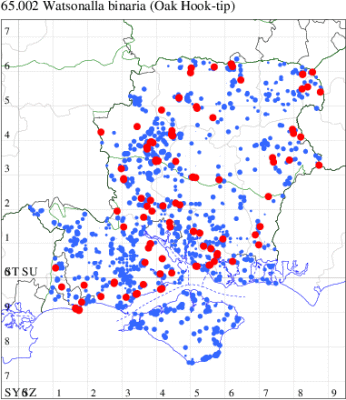
Records by year
Records by week (adult)
Records by week (larval)
Record Summary
VC11: Earliest: Stroud, Petersfield, 04 May, 0 (RAll) Latest: Allbrook, 11 Oct, 1 (SIng) Max count: Lisle Court, Lymington, 08 Sep, 10 (AMus, JPMar)
VC12: Earliest: Pamber Forest, 04 May, 1 (GJD) Latest: Cheriton, 24 Sep, 1 (DAS) Max count: Chilbolton, 09 Sep, 6 (GCE)
65.003 [B&F: 1647] Barred Hook-tip Watsonalla cultraria (Fabricius, 1775) - Local
Local in beech woodland throughout England and Wales. Frequent where beech grows in the New Forest and on the chalk in Hampshire and the Isle of Wight, although rare elsewhere in these counties. Wingspan male 26-32 mm, female 30-35 mm. Main confusion species is Oak Hook-tip W. binaria, but smaller and with a broad dark median fascia across the forewing. Larva feeds on Beech, over-wintering as a pupa.
Records prior to 2023
| Vice County | #Records | #Individuals | First Record | Last Record |
|---|---|---|---|---|
| 10 | 26 | 35 | 1930 | 2022 |
| 11 | 659 | 704 | 1800 | 2022 |
| 12 | 355 | 390 | 1940 | 2022 |
2023 records
| Vice County | #Records | #Individuals | Max Quantity |
|---|---|---|---|
| 11 | 4 | 4 | 1 |
| 12 | 14 | 18 | 5 |
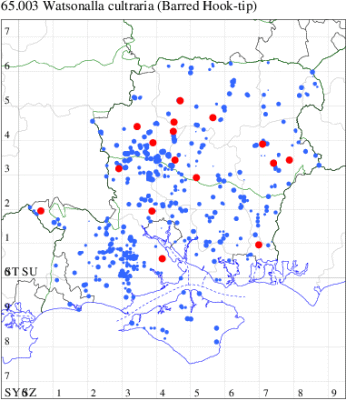
Records by year
Records by week (adult)
Records by week (larval)
Record Details
VC11: East Tytherley, one, 27 Aug (GCE); North Baddesley, one, 27 Jul (RWPas); Dibden Purlieu, NF, one, 29 Jul (RAC); Waterlooville, one, 01 Sep (DWhe);
VC12: Chilbolton, one, 05 Sep; one, 09 Sep (GCE); Anna Valley, Andover, one, 06 Sep (TJN); Littleton, one, 03 Sep; Barton Stacey, one, 11 Sep; Longparish, one, 11 Aug; Cole Henley, one, 27 Jul (GCE); Morn Hill, Winchester, one, 11 Aug (CRB, DAS); one, 02 Sep (CRB, PDF, DAS); five, 09 Sep (CRB, PDF, DAS, LHur); North Waltham, one, 16 Aug (AJon); Alton, one, 07 Sep (DBO); Selborne, one, 17 Aug (CJP); Whitehill, one, 10 Sep (ASto)
65.004 [B&F: 1649] Dusky Hook-tip Drepana curvatula (Borkhausen, 1790) - Rare migrant
Rare immigrant from mainland Europe, appearing in southern and eastern England. First recorded at Dungeness, Kent, in August 1960. In Hampshire the UK's fifth record was discovered at Totton in August 1991. Recorded on the Isle of Wight for the first time at Freshwater in 2002. Wingspan male 37-40 mm, female 40-49 mm. Can easily be overlooked as a dark Pebble Hook-tip D. falcataria, but in that species the outer discal spot on the forewing is much larger than the other two, and on the hindwing the cross-lines in Pebble Hook-tip are more jagged and the wing is noticeably paler towards the costa (MBGBI Vol 7 part 2). Larva feeds on Silver Birch, Downy Birch, Alder and Oak, no evidence of breeding in the UK.
Records prior to 2023
| Vice County | #Records | #Individuals | First Record | Last Record |
|---|---|---|---|---|
| 10 | 4 | 4 | 2002 | 2022 |
| 11 | 4 | 4 | 1991 | 2021 |
2023 records
| Vice County | #Records | #Individuals | Max Quantity |
|---|---|---|---|
| 11 | 1 | 1 | 1 |
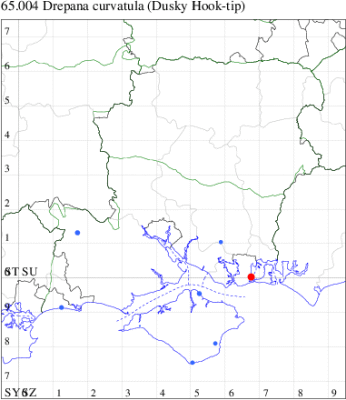
Records by year
Records by week (adult)
Records by week (larval)
Record Details
VC11: Portsmouth*, one, 11 Aug (IRT)
65.005 [B&F: 1648] Pebble Hook-tip Drepana falcataria (Linnaeus, 1758) - Local
Common in woodland, especially of birch, heathland and gardens throughout Britain. Widespread and common in Hampshire and on the Isle of Wight. Wingspan male 36-40 mm, female 40-43 mm. In Scotland moths are distinctly straw-coloured with outer markings darker (ssp. scotica), elsewhere, occasional individuals can be very pale (f. pallida), but only likely to be confused with Dusky Hook-tip D. curvatula, a rare immigrant from Europe, which is darker and has the three discal spots roughly the same size (in falcataria, the outer discal spot is much larger then the other two). Larva feeds on Downy and Silver Birch, over-wintering as a pupa.
Records prior to 2023
| Vice County | #Records | #Individuals | First Record | Last Record |
|---|---|---|---|---|
| 10 | 348 | 417 | 1856 | 2022 |
| 11 | 5472 | 6903 | 1951 | 2022 |
| 12 | 1592 | 2319 | 1951 | 2022 |
2023 records
| Vice County | #Records | #Individuals | Max Quantity |
|---|---|---|---|
| 11 | 82 | 101 | 6 |
| 12 | 30 | 34 | 2 |
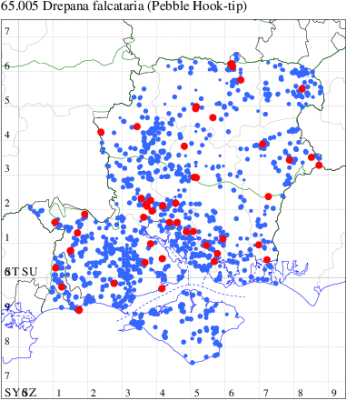
Records by year
Records by week (adult)
Records by week (larval)
Record Summary
VC11: Earliest: Romsey, 10 May, 1 (MJB) Latest: Allbrook, 26 Aug, 1 (SIng) Max count: Hurn, 29 Jul, 6 (MJef)
VC12: Earliest: Magdalen Hill Down NR, 30 Apr, 1 (AMD) Latest: Pamber Forest, 04 Sep, 1 (GJD) Max count: Grayshott, 06 Aug, 2 (THard)
65.007 [B&F: 1651] Chinese Character Cilix glaucata (Scopoli, 1763) - Common
Common in hedgerows, scrub, open woodland and gardens throughout England, Wales, southern Scotland and Ireland. In Hampshire and on the Isle of Wight quite common in areas where hawthorn occurs, but may have declined in recent years. Wingspan 22-27 mm. Unmistakable. Larva feeds on Blackthorn, Hawthorn and Crab Apple, over-wintering as a pupa.
Records prior to 2023
| Vice County | #Records | #Individuals | First Record | Last Record |
|---|---|---|---|---|
| 10 | 761 | 1011 | 1959 | 2022 |
| 11 | 3182 | 3710 | 1950 | 2022 |
| 12 | 1189 | 1544 | 1949 | 2022 |
2023 records
| Vice County | #Records | #Individuals | Max Quantity |
|---|---|---|---|
| 11 | 100 | 110 | 3 |
| 12 | 60 | 79 | 5 |
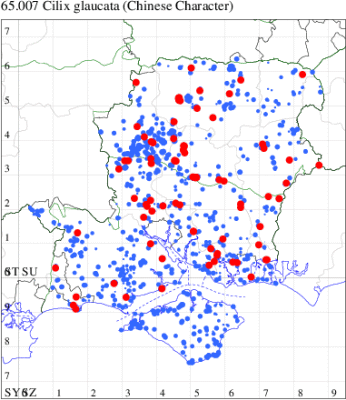
Records by year
Records by week (adult)
Records by week (larval)
Record Summary
VC11: Earliest: Old Winchester Hill, 28 Apr, 1 (F.M.G.) Latest: Botley, 03 Oct, 1 (SLB) Max count: Pennington, 08 Sep, 3 (RFC)
VC12: Earliest: Littleton, 22 May, 1 (GCE) Latest: Morn Hill, Winchester, 09 Sep, 1 (CRB, PDF, DAS, LHur) Max count: Morn Hill, Winchester, 02 Sep, 5 (CRB, PDF, DAS)